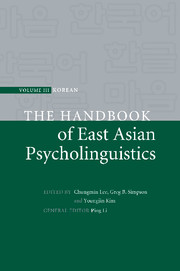Book contents
- Frontmatter
- Contents
- List of figures
- List of tables
- List of contributors
- Preface
- Introduction: Advances in Korean psycholinguistics
- Part I Language acquisition
- 1 Acquisition of the subject and topic nominals and markers in the spontaneous speech of young children in Korean
- 2 The acquisition of argument structure and transitivity in Korean: a discourse-functional approach
- 3 Acquisition of case markers and grammatical functions
- 4 Do Korean children acquire verbs earlier than nouns?
- 5 The acquisition of the placement of the verb in the clause structure of Korean
- 6 Learning locative verb syntax: a crosslinguistic experimental study
- 7 Language-specific spatial semantics and cognition: developmental patterns in English and Korean
- 8 Acquisition of negation in Korean
- 9 The acquisition of Korean numeral classifiers
- 10 Acquisition of Korean reflexive anaphora
- 11 The Korean relative clause: issues of processing and acquisition
- 12 The accessibility hierarchy in Korean: head-external and head-internal relative clauses
- 13 Development of functional categories in child Korean
- 14 The acquisition of modality
- 15 The syntax of overmarking and kes in child Korean
- 16 Events in passive development
- 17 Universal quantification in child grammar
- 18 Acquisition of prosody in Korean
- 19 Korean as a heritage language
- 20 Maturational effects on L2 acquisition
- 21 L2 acquisition of English articles by Korean speakers
- 22 The acquisition of wanna contraction by adult Korean learners of English
- 23 Phonological abilities of Korean–English bilinguals
- 24 Parameters on languages in contact: an altered view of codeswitching
- 25 Influence of socio-psychological categories in bilingual interaction
- 26 Ontological concept versus shape in word learning from a crosslinguistic point of view
- 27 Notes on Korean Sign Language
- Part II Language processing
- References
- Name index
- Subject index
9 - The acquisition of Korean numeral classifiers
from Part I - Language acquisition
Published online by Cambridge University Press: 05 June 2012
- Frontmatter
- Contents
- List of figures
- List of tables
- List of contributors
- Preface
- Introduction: Advances in Korean psycholinguistics
- Part I Language acquisition
- 1 Acquisition of the subject and topic nominals and markers in the spontaneous speech of young children in Korean
- 2 The acquisition of argument structure and transitivity in Korean: a discourse-functional approach
- 3 Acquisition of case markers and grammatical functions
- 4 Do Korean children acquire verbs earlier than nouns?
- 5 The acquisition of the placement of the verb in the clause structure of Korean
- 6 Learning locative verb syntax: a crosslinguistic experimental study
- 7 Language-specific spatial semantics and cognition: developmental patterns in English and Korean
- 8 Acquisition of negation in Korean
- 9 The acquisition of Korean numeral classifiers
- 10 Acquisition of Korean reflexive anaphora
- 11 The Korean relative clause: issues of processing and acquisition
- 12 The accessibility hierarchy in Korean: head-external and head-internal relative clauses
- 13 Development of functional categories in child Korean
- 14 The acquisition of modality
- 15 The syntax of overmarking and kes in child Korean
- 16 Events in passive development
- 17 Universal quantification in child grammar
- 18 Acquisition of prosody in Korean
- 19 Korean as a heritage language
- 20 Maturational effects on L2 acquisition
- 21 L2 acquisition of English articles by Korean speakers
- 22 The acquisition of wanna contraction by adult Korean learners of English
- 23 Phonological abilities of Korean–English bilinguals
- 24 Parameters on languages in contact: an altered view of codeswitching
- 25 Influence of socio-psychological categories in bilingual interaction
- 26 Ontological concept versus shape in word learning from a crosslinguistic point of view
- 27 Notes on Korean Sign Language
- Part II Language processing
- References
- Name index
- Subject index
Summary
Introduction
One of the most remarkable aspects of the Korean language which differentiates it from English is that Korean noun phrases, when quantified, obligatorily require classifiers (CL), exemplified by (1):
(1) Haksayng sey-myeng- i iss-ta.
student three-CL-NOM be-DEC.
‘There are three students.’
[Noun-Quantifier-Classifier]
Since the characteristics and criteria of Korean classifiers have not been precisely defined, the total number of Korean classifiers is not clear. There are about 290 classifiers which have been identified. Some of them appear to be productively used, but some are not (Im, 1991a, b).
Classifiers pose an interesting question for first-language acquisition since they require knowledge of both syntax and semantics. Syntactically, they reflect functional heads of quantifier phrases, whose order and position are fixed. The typical word order of a Korean quantifier noun phrase is [Noun-Quantifier-Classifier], as in (1) (Im, 1991a,b; see also Sohn, 1999 and C. Lee, 2000). There are some other structures of the Korean quantifier noun phrase, but we will not discuss them here.
Semantically, classifiers reflect a language-specific agreement system in semantic features between the head noun and the classifier. Although categorization of features of the Korean classifiers has not been defined clearly yet, features of the Korean classifier system can be organized according to Adams and Conklin's (1973) three basic features of animacy, shape, and function. Also, the Korean classifier system consists of several other specific features, such as honorific and event. The agreement system in semantic features between the noun and the classifier is well developed in Korean.
- Type
- Chapter
- Information
- The Handbook of East Asian Psycholinguistics , pp. 137 - 149Publisher: Cambridge University PressPrint publication year: 2009
- 1
- Cited by



